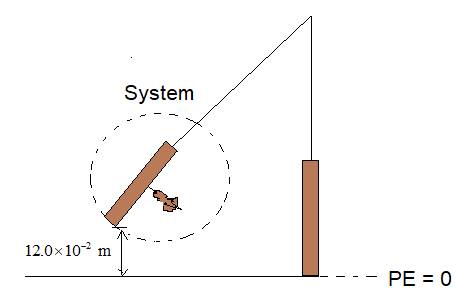
Concept explainers
(a)
To sketch the situation and choose the system.
(a)
Explanation of Solution
Given:
Mass of a magnetic target suspended on a string is
Mass of a magnetic dart, shot horizontally, and strikes the target head-on is
The height above the initial level at which the dart and target together swings like a pendulum is
Suspended magnetic target and the magnetic dart which strikes the target makes the system. The situation is sketched as shown in figure 1.

Figure 1
(b)
To decide and describe what is conserved in each step of the process.
(b)
Answer to Problem 23PP
During the inelastic collision between the magnetic target and the magnetic dart, momentum is conserved and the energy is conserved when the magnetic target - magnetic dart combination swings upward.
Explanation of Solution
Introduction:
Law of conservation of momentum: The law of conservation of momentum states that when collision occurs between the two bodies in an isolated system then total momentum of two bodies before collision is equivalent to the total momentum of that two bodies after the collision.
Law of conservation of energy: It states that total energy of an isolated system is conserved. That is, it remains persistent over a time.
During the inelastic collision between the magnetic target and the magnetic dart, momentum is conserved. Therefore, momentum of the system before collision is equal to the momentum of the system after collision. This can be expressed as,
Where,
Substituting all these in equation
Where,
Now, the equation
And, the energy is conserved during the upward swing of magnetic target-magnetic dart combination. Thus, at the topmost of the swing, potential energy of the system is equal to the kinetic energy of the system. This can be represented as,
Where,
Substituting these values in equation
Where
(c)
The initial velocity of the dart.
(c)
Answer to Problem 23PP
Explanation of Solution
Given:
Mass of a magnetic target suspended on a string is
Mass of a magnetic dart, shot horizontally, and strikes the target head-on is
The height above the initial level at which the dart and target together swings like a pendulum is
Formula used:
From the conservation of momentum equation
From the conservation of energy equation
Substituting for
Calculation:
Initial velocity of the magnetic dart can be calculated by substituting the numerical values in equation
Conclusion:
Initial velocity of the magnetic dart is
Chapter 11 Solutions
Glencoe Physics: Principles and Problems, Student Edition
Additional Science Textbook Solutions
Tutorials in Introductory Physics
University Physics with Modern Physics (14th Edition)
Physics for Scientists and Engineers: A Strategic Approach with Modern Physics (4th Edition)
University Physics Volume 2
College Physics (10th Edition)
Conceptual Physics (12th Edition)
 College PhysicsPhysicsISBN:9781305952300Author:Raymond A. Serway, Chris VuillePublisher:Cengage Learning
College PhysicsPhysicsISBN:9781305952300Author:Raymond A. Serway, Chris VuillePublisher:Cengage Learning University Physics (14th Edition)PhysicsISBN:9780133969290Author:Hugh D. Young, Roger A. FreedmanPublisher:PEARSON
University Physics (14th Edition)PhysicsISBN:9780133969290Author:Hugh D. Young, Roger A. FreedmanPublisher:PEARSON Introduction To Quantum MechanicsPhysicsISBN:9781107189638Author:Griffiths, David J., Schroeter, Darrell F.Publisher:Cambridge University Press
Introduction To Quantum MechanicsPhysicsISBN:9781107189638Author:Griffiths, David J., Schroeter, Darrell F.Publisher:Cambridge University Press Physics for Scientists and EngineersPhysicsISBN:9781337553278Author:Raymond A. Serway, John W. JewettPublisher:Cengage Learning
Physics for Scientists and EngineersPhysicsISBN:9781337553278Author:Raymond A. Serway, John W. JewettPublisher:Cengage Learning Lecture- Tutorials for Introductory AstronomyPhysicsISBN:9780321820464Author:Edward E. Prather, Tim P. Slater, Jeff P. Adams, Gina BrissendenPublisher:Addison-Wesley
Lecture- Tutorials for Introductory AstronomyPhysicsISBN:9780321820464Author:Edward E. Prather, Tim P. Slater, Jeff P. Adams, Gina BrissendenPublisher:Addison-Wesley College Physics: A Strategic Approach (4th Editio...PhysicsISBN:9780134609034Author:Randall D. Knight (Professor Emeritus), Brian Jones, Stuart FieldPublisher:PEARSON
College Physics: A Strategic Approach (4th Editio...PhysicsISBN:9780134609034Author:Randall D. Knight (Professor Emeritus), Brian Jones, Stuart FieldPublisher:PEARSON





